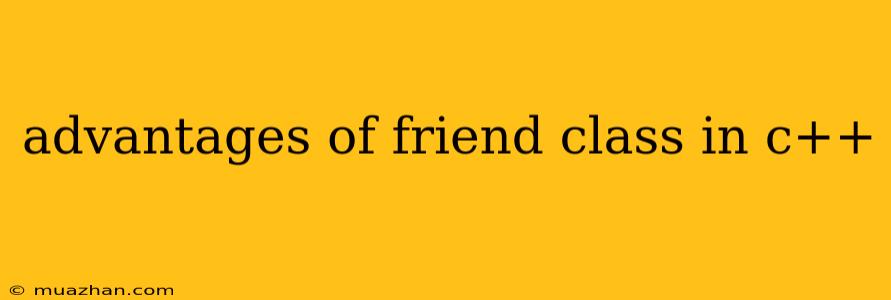Advantages of Friend Class in C++
In C++, the concept of friend classes allows classes to grant access to their private and protected members to other classes, even though they are not part of the same class hierarchy. This seemingly unorthodox approach can be incredibly beneficial in specific scenarios, offering several advantages over traditional member function access. Here's a breakdown of the key advantages of using friend classes:
1. Enhanced Encapsulation and Data Hiding
While the core principle of object-oriented programming emphasizes encapsulation and data hiding, friend classes offer a controlled way to relax these restrictions. This can be advantageous when:
- Interacting with complex data structures: Friend classes can access and manipulate private members of other classes without violating encapsulation principles. This allows for more efficient and direct interactions with complex data structures, such as linked lists or binary trees, without requiring convoluted public interfaces.
- Implementing collaborations between classes: Friend classes facilitate seamless collaboration between classes, allowing them to share and modify data in a controlled manner. This is particularly useful in scenarios where classes need to work together to achieve a common goal.
2. Optimized Data Access and Performance
Direct access to private and protected members through friend classes can lead to significant performance gains.
- Reduced overhead: By avoiding the need for public accessor and mutator methods, friend classes can eliminate the overhead associated with function calls, leading to faster data access and manipulation.
- Improved efficiency: In scenarios where frequent access to private members is required, using friend classes can significantly optimize performance by reducing the number of function calls and simplifying the underlying logic.
3. Flexibility in Code Design
Friend classes provide a powerful tool for designing flexible and modular code.
- Simplified class design: Friend classes can help simplify the design of classes by allowing them to focus on their core functionalities while leaving data manipulation to dedicated friend classes.
- Code reusability: Friend classes can be used to create reusable code modules that can be incorporated into different parts of the application, promoting modularity and code reusability.
4. Controlled Access and Security
Despite granting access to private members, friend classes still offer a degree of control and security.
- Selective access: Friend classes can be selectively granted access to specific private members, allowing for fine-grained control over data access.
- Enhanced security: By carefully choosing which classes are designated as friends, you can ensure that only authorized classes have access to sensitive data.
5. Real-World Examples
Friend classes find practical applications in various real-world scenarios, including:
- Database interaction: Friend classes can be used to provide secure access to database objects without exposing the entire database structure to external classes.
- Network communication: Friend classes can be utilized to facilitate efficient communication between network protocols and data structures, ensuring secure and optimized data exchange.
- Graphics rendering: Friend classes can be employed to manage and manipulate graphical objects, allowing for faster and more efficient rendering processes.
Conclusion
Friend classes offer a powerful tool for C++ developers, providing a controlled way to relax encapsulation principles and optimize data access. By understanding the advantages and potential drawbacks of friend classes, developers can leverage this feature to build robust, efficient, and secure applications. However, it's crucial to use friend classes judiciously, as indiscriminate use can compromise encapsulation and make code harder to maintain.
